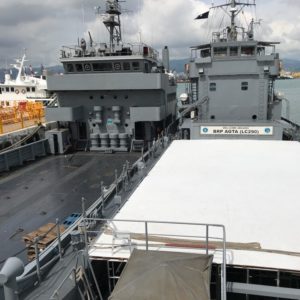
Work is underway at the Naval Forces Central (Navforcen) dockyard in Lapu-Lapu City for the fluvial procession on Saturday / CDN PHOTO MARC COSEP
Work is underway at the Naval Forces Central (Navforcen) dockyard in Lapu-Lapu City to prepare one of its top vessels for the fluvial procession on Saturday.
An elevated platform which towers over BRP Agta LC-290 was purposely put up at the vessel’s bow for people to easily see the images of the Sto. Niño and the Our Lady of Guadalupe.
“We’re privileged that the Sto. Niño will be on board our boat in this year’s fluvial procession,” said Ensign Maria Amanda Precious Zamuco, public affairs officer of the Navforcen.
Unknown to many, the Sto. Niño de Cebu holds a military rank of a captain general since the Spanish rule as manifested in its sash, boots, and belt studded with old Spanish coins.
It was specifically recognized as Celentisimo Capitan General de las Esfuerzas Española en Filipinas (Most Esteemed Captain General of the Spanish Forces in the Philippines).
In 2011, the image was given the title “Lord Admiral of the Sea” by the Philippine Navy in acknowledgment of Christ’s lordship over seafarers, mariners and the marine ecology.
Commodore Loumer Bernabe, commander of Navforcen, said it is but proper for them to honor the child Jesus who has immensely blessed Cebu and the rest of the region.
“Señor Sto. Niño is part of the Navy especially here in Cebu. We’re giving him the honor,” he said in an interview on Wednesday.
“The Naval Forces Central is very much thankful to the basilica fathers for choosing us as the main platform (to carry the Sto. Niño) during the fluvial procession. I hope it will bring more blessings to the Philippine Navy, the whole of the Armed Forces of the Philippines, and the entire region,” he added.
In the 37-year history of the fluvial procession, the family of the late Ernesto Ouano Sr. of Mandaue City provided the yacht or galleon replica for the Sto. Niño and the Our Lady of Guadalupe.
This year, however, the Augustinian fathers of the Basilica Minore del Sto. Niño, decided to give other ship owners the chance to ferry the sacred images in response to several requests.
The Navy was subsequently chosen to bring the images of the Sto. Niño and the Our Lady of Guadalupe back to Cebu City during Saturday’s sea procession.
Ensign Zamuco said the BRP Agta, this year’s “galleon” of the Sto. Niño, was owned by the Australian Navy since the 1970s before it was entrusted to Navforcen in 2016.
“It used to be known as Her Majesty’s Ship before we renamed it to BRP Agta in honor of the Aeta groups,” she explained.
Zamuco said it has been their practice to name naval vessels after indigenous groups in the Philippines.
BRP Agta, she said, has been used for Navforcen’s humanitarian and disaster relief operations.
The naval vessel has a capacity of about 150 persons. Allowed to board the BRP Agta during the fluvial procession are Cebu Archbishop Jose Palma, the Augustinian and diocesan priests, the current and former Hermano and Hermana Mayores, and men dressed in Spanish soldiers who have roles to play during the reenactment of the first Mass, baptism, and wedding to be held at the basilica after the sea procession.
Zamuco said seven other vessels of Navforcen will be used during the fluvial procession.
The Navforcen compound will be opened to people who want to witness the sea procession which will start at 6 a.m.
For the first time, the images of the Sto. Niño and the Our Lady of Guadalupe will drop by the Nuestra Señora de Regla National Shrine in Lapu-Lapu City shortly before the start of the sea procession.
The Augustinian fathers, the first missionaries who arrived in Philippine soil and the caretakers of the Sto. Niño image, extended the annual traslacion from Mandaue City to Lapu-Lapu City in response to numerous requests from Oponganons who want to be visited by the images during the festivities.
The annual traslacion or ritual transfer of the images of the Sto. Niño and the Our Lady of Guadalupe started with a motorcade from the basilica to the National Shrine of St. Joseph in Mandaue City on Friday.
After an overnight vigil and Mass in Mandaue City, the images will be transported in a motorcade to the Nuestra Señora de Regla National Shrine in Lapu-Lapu City where it will stay for about two hours before it will be brought to the Navforcen port for the fluvial procession.

